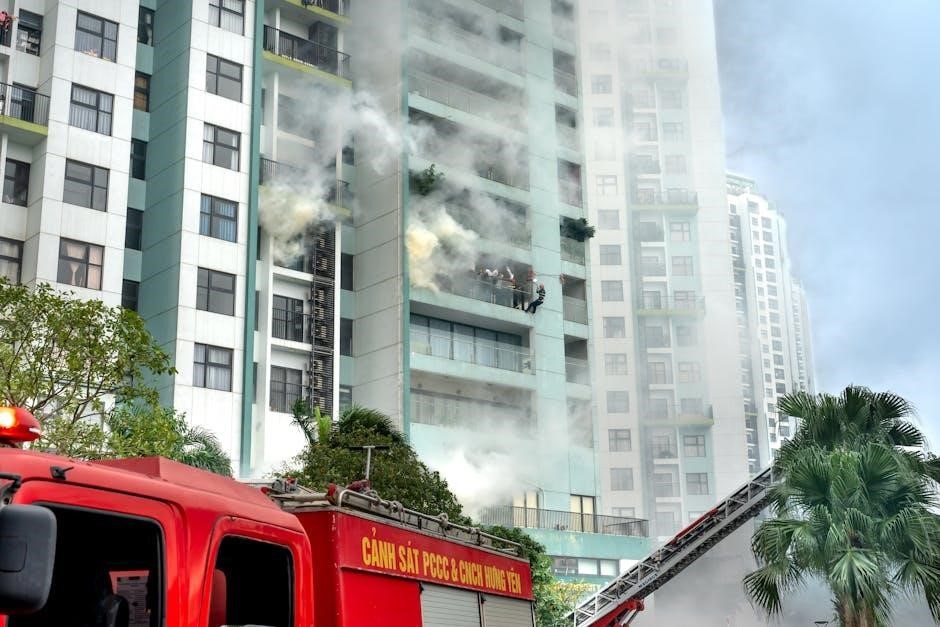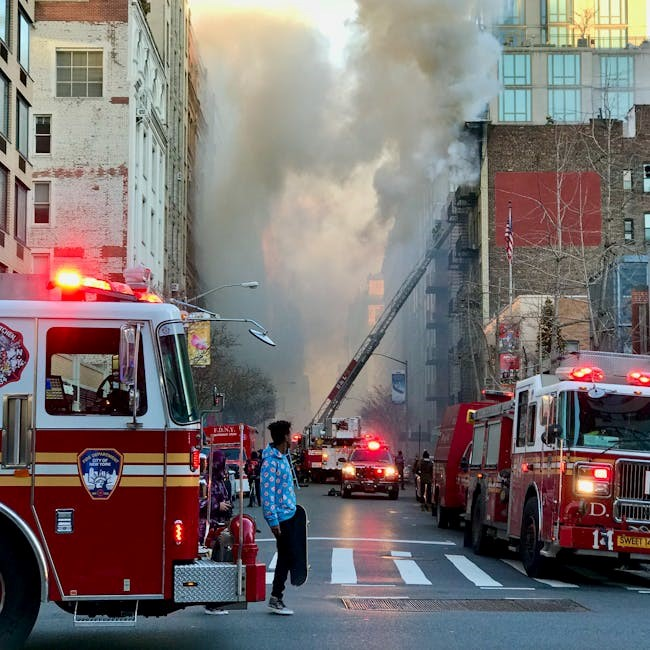Manual fire alarms are essential components in fire safety systems, providing a reliable method for immediate activation in emergencies, ensuring timely responses and enhancing safety while complying with regulations․
1․1 Definition and Purpose
Manual fire alarms are devices designed to initiate an alert in case of a fire, enabling quick evacuation and emergency response․ They consist of pull stations or call points, which, when activated, trigger audible and visual alarms․ Their primary purpose is to ensure timely warnings, reducing risks to life and property․ These systems are crucial in public and residential buildings, providing a reliable method for individuals to signal a fire emergency․ By enabling immediate action, manual fire alarms play a vital role in fire safety, complementing automatic detection systems and ensuring compliance with fire safety regulations․
1․2 Importance in Fire Safety Systems
Manual fire alarms are critical in fire safety systems as they provide a direct means for individuals to signal a fire, ensuring rapid response and evacuation․ Their presence enhances situational awareness, allowing occupants to take immediate action․ Unlike automatic systems, manual alarms rely on human intervention, which can be vital in situations where smoke or heat is not sufficient to trigger automatic detectors․ This dual approach improves overall fire safety, offering redundancy and reliability․ By providing a straightforward activation method, manual fire alarms contribute significantly to protecting lives and property, making them indispensable in comprehensive fire safety strategies․

Components of a Manual Fire Alarm System
Manual fire alarm systems include pull stations and call points as primary activation devices, along with alarm panels and control units that process and transmit signals effectively․
2․1 Pull Stations and Call Points
Manual fire alarm pull stations and call points are critical components, enabling individuals to trigger alerts during emergencies․ These devices are strategically positioned for easy access, ensuring rapid response․ They typically feature durable designs to withstand frequent use and harsh environments․ Pull stations are commonly found in public areas, while call points are often used in industrial settings․ Both devices are essential for initiating alarm signals, thereby alerting occupants and authorities to potential fire hazards․ Their reliability ensures timely evacuation and emergency response․
2․2 Alarm Panels and Control Units
Alarm panels and control units serve as the central hubs of manual fire alarm systems, processing signals from pull stations and call points․ These units monitor the entire system, detecting activations and faults․ They often feature advanced programming for customized responses, such as triggering alarms, notifications, or building-wide alerts․ Modern control units include diagnostic capabilities, ensuring system reliability․ Compliance with fire safety standards is crucial, as these units must handle multiple zones and integrate with other safety systems․ Their durability and functionality are vital for maintaining fire safety in various environments, from residential to industrial settings․
How Manual Fire Alarms Function
Manual fire alarms function by enabling individuals to trigger alerts during emergencies, activating audible and visual signals to prompt immediate evacuation and response from emergency services․
3․1 Activation Methods
Manual fire alarms are activated through pull stations or call points, which are strategically located throughout buildings․ Pull stations require a physical pull or lift to trigger the alarm, while call points are often operated by breaking glass or pressing a button․ These devices are designed for easy access during emergencies, ensuring quick notification of a potential fire hazard․ Proper activation methods are crucial to prevent false alarms and ensure timely responses․ Compliance with local fire codes guarantees these systems are reliable and effective in initiating emergency procedures, safeguarding occupants and property․
3․2 Signal Transmission and Response
Upon activation, manual fire alarms transmit signals to a central control panel, which processes the information and triggers audible and visual alerts throughout the building․ This immediate notification ensures occupants are informed of potential dangers, enabling swift evacuation․ The system may also send alerts to emergency services or monitoring centers, facilitating a rapid response․ Reliable signal transmission is critical to prevent delays in emergency actions․ Compliance with local fire codes ensures that these systems operate efficiently, minimizing risks and enhancing overall safety․ Proper signal transmission and response protocols are vital for effective fire management and safeguarding lives and property․
Installation and Placement Guidelines
Manual fire alarms must be strategically installed in visible, accessible locations such as corridors and exits, ensuring compliance with fire safety codes and easy activation during emergencies․
4․1 Strategic Location in Buildings
Strategic placement of manual fire alarms is critical for effective fire response․ These devices should be installed in high-traffic areas, such as corridors, stairwells, and near emergency exits․ Ensuring visibility and accessibility is essential, as alarms must be easily reachable during emergencies․ They should also be located near potential fire hazards, like kitchens or electrical rooms, to facilitate quick activation․ Compliance with local fire codes ensures that alarms are positioned to maximize safety and efficiency․ Proper placement helps prevent delays in alerting occupants, thereby saving lives and reducing property damage․ Regular inspections confirm that alarms remain visible and accessible․
4․2 Compliance with Local Fire Codes
Adherence to local fire codes is mandatory for manual fire alarm installations․ These regulations ensure systems meet safety standards, guaranteeing reliability and effectiveness․ Codes often specify requirements for alarm placement, spacing, and visibility․ Compliance involves regular inspections and testing to maintain functionality․ Fire authorities enforce these standards, conducting audits to verify adherence․ Non-compliance can result in penalties, compromising building safety․ By following local fire codes, manual fire alarms contribute to a safer environment, protecting occupants and property․ Proper documentation of compliance is essential for legal and insurance purposes, ensuring accountability and preparedness in emergencies․ This due diligence is a cornerstone of fire safety management․
Maintenance and Testing Requirements
Regular inspections and functional tests ensure manual fire alarms operate reliably, maintaining safety standards and preventing system failures during emergencies, while adhering to legal requirements and regulations․
5․1 Regular Inspections and Checks
Regular inspections of manual fire alarms are crucial to ensure systems function correctly․ These checks involve visual examinations of pull stations, wiring, and alarm panels to identify potential issues․ Testing components like batteries and signaling devices ensures reliability․ Inspections should be conducted weekly or monthly, depending on local regulations, to maintain compliance and safety standards․ Faulty or damaged parts must be repaired promptly to prevent system failure during emergencies․ Proper documentation of inspections and maintenance activities is essential for audit purposes and to demonstrate adherence to fire safety regulations․
5․2 Testing Protocols for Reliability
Testing protocols for manual fire alarms ensure system reliability and effectiveness․ Routine functional tests, such as activating pull stations and verifying alarm signals, are conducted to confirm proper operation․ Signal transmission tests verify that alerts reach monitoring systems or fire authorities․ Battery tests and wiring inspections are also performed to identify potential failures․ These tests are typically conducted quarterly or annually, depending on local fire codes․ Documentation of test results is crucial for compliance and to identify trends that may require maintenance․ Certified professionals often oversee these protocols to ensure adherence to safety standards and system performance․

Legal and Regulatory Standards
Manual fire alarms must comply with legal and regulatory standards, enforced by fire authorities, to ensure safety and reliability, adhering to specific fire safety laws and codes․
6․1 Fire Safety Laws and Regulations
Fire safety laws and regulations mandate the installation and maintenance of manual fire alarms in various occupancies, including hotels and apartments, to ensure timely emergency responses․ These laws outline specific requirements for the placement and functionality of manual fire alarm systems, ensuring they meet established safety standards․ Compliance with these regulations is critical to safeguarding lives and property․ Authorities enforce these laws through regular inspections and penalties for non-compliance, ensuring that fire safety measures remain reliable and effective in all settings․
6․2 Role of Fire Authorities in Enforcement
Fire authorities play a crucial role in enforcing fire safety laws and regulations, ensuring manual fire alarm systems are installed and maintained correctly․ They conduct regular inspections to verify compliance with local fire codes and standards․ Non-compliance can result in penalties or mandatory upgrades․ Fire authorities also provide guidelines and support to building owners and managers to help them understand and meet legal requirements․ Their enforcement efforts are essential for maintaining public safety and preventing fire-related risks in residential and commercial properties․ Proper enforcement ensures that manual fire alarms function reliably during emergencies․

Best Practices for Usage
Proper usage of manual fire alarms ensures safety and effectiveness, minimizing false alarms while promoting quick responses during emergencies, essential for safeguarding lives and property efficiently․
7․1 Proper Activation Techniques
Proper activation of manual fire alarms involves locating the nearest pull station or call point and operating it correctly to signal an emergency․ This ensures the alarm system triggers promptly, alerting everyone in the building․ It is crucial to familiarize oneself with the device’s mechanism, whether it’s a pull lever or a breakable glass, to activate it without hesitation․ Proper technique prevents accidental damage and ensures the system functions as intended during a real emergency․ Regular training and drills can reinforce these activation methods, promoting readiness and efficiency in critical situations․ Awareness and quick action are key to effective fire safety․
7․2 Avoiding False Alarms
Avoiding false alarms is critical to maintaining the reliability and effectiveness of manual fire alarm systems․ False activations can lead to complacency, disruption of operations, and potential fines․ To prevent them, ensure pull stations are securely installed and protected from accidental triggering․ Conduct regular maintenance and inspections to identify and address issues promptly․ Training staff and residents on proper alarm activation is essential․ Encourage a culture of responsibility, emphasizing the consequences of false alarms․ Strategic placement of manual fire alarms in areas with minimal accidental activation risk also helps reduce false triggers․ Quick response protocols should be in place to address any unintended activations swiftly․

Future Trends and Innovations
Manual fire alarms are evolving with smart technology integration, offering enhanced reliability and efficiency, while future innovations aim to improve response times and system connectivity for better safety outcomes․
8․1 Integration with Smart Technology
Manual fire alarms are increasingly being integrated with smart technology, enabling real-time monitoring and remote notifications․ This connectivity allows for faster response times and improved efficiency in emergencies․ Advanced systems now incorporate IoT devices, enabling seamless communication between fire alarms and building management systems․ Additionally, mobile apps provide instant alerts and system controls, enhancing accessibility․ Data analytics from these integrated systems can predict potential risks and optimize maintenance schedules․ This fusion of traditional manual systems with modern smart solutions is revolutionizing fire safety, ensuring greater reliability and adaptability in safeguarding lives and property․
8․2 Enhanced Reliability and Efficiency
Manual fire alarms have seen significant advancements in reliability and efficiency․ Improved manufacturing processes and rigorous testing protocols ensure that these systems perform dependably in critical situations․ Enhanced designs reduce false alarms, minimizing disruptions and ensuring responses are reserved for genuine emergencies․ Regular maintenance plays a crucial role in sustaining efficiency, as outlined in fire safety regulations․ These improvements mean that when an alarm is activated, it reliably triggers the necessary alerts and responses, thereby saving valuable time in emergency situations․ Overall, the focus on reliability and efficiency underscores the vital role manual fire alarms play in modern fire safety systems․
